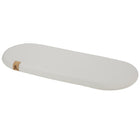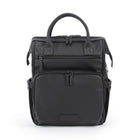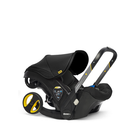The start of the weaning journey can be an overwhelming time for both parents and baby. There are many worries parents share when approaching the weaning stage. However, most of these concerns have logical answers.
The most common anxieties parents share are surrounding their baby’s safety. For instance, how to tell the difference between gagging and choking is a fear for many. This is why this Child Safety Week, we want to give you an introduction to safe weaning and address any doubts you may have before you and your baby start the weaning journey.
What is Weaning?
Weaning is the introduction of solid foods alongside your baby’s usual breast milk or first infant formula. Solid foods are usually introduced around 6 months of age.
What is Baby Led Weaning?
Baby-led weaning is where you allow your baby to feed themselves rather than spoon-feeding them. You offer them a selection of foods to choose from themselves.
Weaning Essentials
-
High Chair – your baby needs to learn from an early age that they must be sat down when eating so that they can swallow their food properly. Always make sure that they are sat upright and strapped in. Remember, never leave your baby unattended when eating.
-
Muslin Cloths – you will probably already have plenty of these from when your baby first arrived. But these will also come in handy during spoon-feeding to clean up any spills or sick.
-
Bibs – weaning can get messy. So plastic bibs are the best for the beginning.
-
Plastic bowls – that have individual compartments are ideal to keep different flavours and textures separated. You should also opt for bowls with a suction pad to avoid any accidents.
-
Soft spoons – that are safe for your baby’s gums.
Introducing New Textures
When planning what meals to feed your baby, you should consider the size, shape and texture of the food you will be serving them. It is important to keep in mind that some babies may need smooth or blended foods to start with until they get used to new textures.
However, don’t worry if your baby refuses lumpy textures at the beginning. The NHS encourages you to keep offering your baby lumpy textures. They will get used to them eventually. The introduction of lumpy and mashed food alongside finger foods is essential. It helps your baby learn to chew, move solid food around their mouth and swallow.
Be Patient
Remember that patience is key when introducing your baby to new foods. Eating is a whole new skill for them, and you should always go at your baby’s pace.
How to Serve Food Safely
Hygiene
Babies are highly vulnerable to bacteria that can cause food poisoning. Therefore, you need to be extra careful when preparing and storing food for your little one. Basic hygiene, like washing your hands before preparing food. Should always be followed. But if you need a knowledge refresh, take a look at the BBC Good Food guide to safely preparing and storing food here.
Preparing Food
The main worry mums have when weaning their baby is the risk of choking. Choking can happen at any time with any food. But certain foods, such as small round foods, firm foods and foods with bones, can present a higher risk.


DO
- Remove hard pips and stones from fruit.
- Cut food into narrow batons.
- Avoid round shapes.
- Try grating, mashing, steaming or simmering firm fruits.
- Remove the skin on fruit, vegetables and meat.
- Remove all bones from meat or fish.
DON’T
- Do not give whole nuts to children under 5 years old.
- Do not give babies and young children boiled, hard, gooey or sticky sweets.
- Do not give popcorn to babies and young children.
- Do not give babies chewing gum or marshmallows.
For a full list of foods to avoid read the Start 4 Life safe weaning guide here.
Family Mealtimes
During mealtimes, you and your family members should all sit down together as much as possible. Mealtimes are the perfect opportunity for your baby to observe how you eat. By acting as good role models when eating, they can learn from the beginning how to eat safely. Babies copy their parents and other children, so it is important that you are a positive influence. You can do this by sitting upright, breaking your food up and chewing properly.
Gagging
It is normal for your baby to gag when you introduce them to solid foods. As we mentioned earlier, eating is a whole new skill for them. It will take them time to learn how the regulate the amount of food they can chew and swallow at one time.
Further Information
For more information regarding how to know when your baby is ready to wean. Or how to tell the difference between gagging and choking. You can visit the NHS website. You can also ask a health professional for support.






















































































